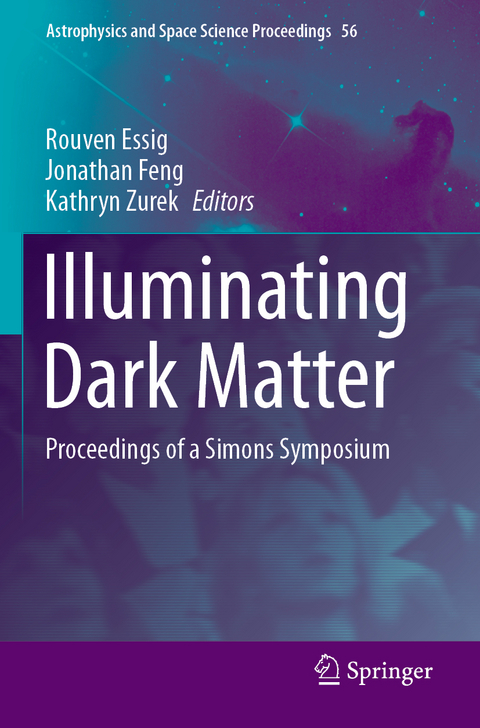
Illuminating Dark Matter
Springer International Publishing (Verlag)
978-3-030-31595-5 (ISBN)
Rouven Essig is an Associate Professor of Physics at the C.N. Yang Institute for Theoretical Physics (YITP) at Stony Brook University in Stony Brook, New York. He is a particle physicist studying the fundamental building blocks of matter (particles) and their interactions (forces), and how they shape our Universe.
Professor Essig was born and grew up in South Africa. His undergraduate education took place at the University of the Witwatersrand in Johannesburg. He received his PhD in 2008 from Rutgers University and was a Research Associate at SLAC National Accelerator Laboratory at Stanford University from 2008 to 2011, before joining the faculty at Stony Brook University in 2011.
Professor Jonathan Feng works at the interface of particle physics and cosmology, with the goal of exploring the deep connections between our understanding of the Universe at the smallest and largest length scales. Feng has contributed to global developments in the field through wide-ranging work on new particles and forces, dark matter, collider physics, cosmic rays, supersymmetry, and extra dimensions.
Feng holds degrees in physics and mathematics from Harvard, Cambridge, and Stanford universities. He joined the UC Irvine faculty in 2001 and was appointed Professor and Chancellor's Fellow in 2006. His work has been recognized by an NSF CAREER Award, UCI's Distinguished Assistant Professor Award for Research, the Outstanding Young Researcher Award from the International Association of Chinese Physicists and Astronomers, a Sloan Research Fellowship, a Guggenheim Fellowship, AAAS Fellowship, and Simons Fellow and Investigator Awards.He has been a member and officer of the Aspen Center for Physics, co-chair of the Advisory Board of the Kavli Institute for Theoretical Physics, and editor-in-chief and editor of the journals Open Physics, Nuclear Physics B, and Physics Reports. He has served in advisory roles for the U.S. National Science Foundation, the Department of Energy, and NASA, as well as for national science funding agencies abroad, including those of Austria, Canada, Hong Kong, Israel, the Netherlands, Switzerland, Taiwan, and the United Kingdom.
Kathryn Zurek joined the LBNL theory group in 2014. She completed her PhD in 2006 at the University of Washington (with David B. Kaplan), and then became a postdoc at the University of Wisconsin, Madison. She was awarded the David Schramm fellowship at Fermilab in 2008 before becoming an assistant and then associate professor at the University of Michigan. In 2010, she was a recipient of an NSF CAREER award.
Dr. Zurek has a wide range of interests, mostly focused at the boundary of particle physics with astrophysics and cosmology. Her work spans both studies of new physics signatures at colliders, as well as astrophysical searches for dark matter (DM) and physics beyond the Standard Model in the neutrino sector. She originated Hidden Valley models as a portal to hidden world signatures, including displaced decays, at colliders. More recently, she has been most active in the study of DM, working on theories of DM and ways that we can detect it in the lab by DM-nucleus interactions, at colliders through high energy collisions, and in the galaxy by DM self-annihilations.
Sterile-Neutrino/Dark-Fermion Dark Matter: Searches in the X-ray Sky, the Nuclear Physics Laboratory and in Galaxy Formation.- Constraining the small-scale clustering of dark matter with stellar streams.- Understanding Dwarf Galaxies in order to Understand Dark Matter.- Primordial black holes as dark matter and generators of cosmic structure.- Quantum metrology techniques for axion dark matter detection.- Light Dark Matter Searches at Accelerators and the LDMX Experiment.- Direct Detection of Sub-GeV Dark Matter: Models, and Constraints.- FASER and the Search for Light, Weakly-Interacting Particles.- Interplay of Dark Matter Direct Detection and Neutrino Experiments.- Why I think that dark matter has large self interactions.- Primordial black holes as dark matter: new formation scenarios and astrophysical effects.- Versatile Physics with Liquid Xenon Dark Matter Detectors.- The origin of galaxy scaling laws in LCDM.- Searching for light dark matter with positron beams.- Somedirect detection signatures of sub-MeV dark matter.- 21 cm Absorption as a Probe of Dark Photons.- Some Minimal Cosmologies for Dark Sectors.- The SENSEI experiment.- Indirect Probes of Light Dark Matter.- Halometry from Astrometry: New Gravitational Methods to Search for Dark Matter.- Principles for an Era in Dark Matter Model Building and Their Application to Complex Dark Sectors.
| Erscheinungsdatum | 08.12.2020 |
|---|---|
| Reihe/Serie | Astrophysics and Space Science Proceedings |
| Zusatzinfo | XII, 165 p. 54 illus., 49 illus. in color. |
| Verlagsort | Cham |
| Sprache | englisch |
| Maße | 155 x 235 mm |
| Gewicht | 285 g |
| Themenwelt | Naturwissenschaften ► Physik / Astronomie ► Astronomie / Astrophysik |
| Schlagworte | cosmic structure • Dark Matter • dark matter detection • dark matter detector • dark matter properties • dark matter research • Simons Symposium • weakly interacting particles |
| ISBN-10 | 3-030-31595-9 / 3030315959 |
| ISBN-13 | 978-3-030-31595-5 / 9783030315955 |
| Zustand | Neuware |
| Haben Sie eine Frage zum Produkt? |
aus dem Bereich


